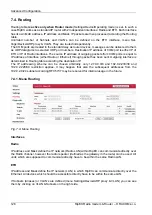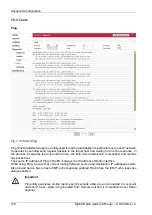
7.4. Routing
Routing table
is active only when Router mode
(Settings/Device/Operating mode) is set. In such a
case RipEX works as a standard IP router with 2 independent interfaces: Radio and ETH. Each interface
has its own MAC address, IP address and Mask. IP packets are then processed according the Routing
table.
Unlimited number of Subnets and VLAN’s can be defined on the ETH interface, menu Set-
tings/Device/ARP proxy & VLAN. They are routed independently.
The COM ports are treated in the standard way as router devices, messages can be delivered to them
as UDP datagrams to selected UDP port numbers. Destination IP address of COM port is either IP of
ETH or IP of Radio interfaces. The source IP address of outgoing packets from COM ports is equal to
IP address of interface (either Radio or Ethernet) through packet has been sent. Outgoing interface is
determined in Routing table according the destination IP.
The IP addressing scheme can be chosen arbitrarily, only 127.0.0.0/8 and 192.0.2.233/30 and
192.0.2.228/30 restriction applies. It may happen that also the subsequent addresses from the
192.0.2.0/24 subnet according RFC5737 may be reserved for internal usage in the future.
7.4.1. Menu Routing
Fig. 7.9: Menu Routing
Interfaces
Radio
IP address and Mask define the IP network (Radio LAN) within RipEX can communicate directly over
the Radio channel, however the radio repeater (defined as the gateway in the route) can be used. All
units which are supposed to communicate directly have to be within the same Radio LAN.
ETH
IP address and Mask define the IP network (LAN) in which RipEX can communicate directly over the
Ethernet. All devices which should be accessible directly have to be within the same LAN.
If Subnets (Aliases) or VLAN’s are defined (menu Settings/Device/ARP proxy & VLAN) you can see
them by clicking on VLAN & Subnets on the right side.
RipEX Radio modem & Router – © RACOM s.r.o.
128
Advanced Configuration
Содержание RipEX 1.6.0
Страница 2: ......
















































